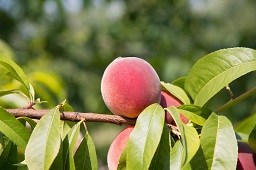Article from
VSCNews, Vegetable and Specialty Crop News
by Ali Sarkhosh
Peach Training and Pruning Pointers

The excessive vegetative growth of low-chill peaches under tropical
and subtropical climates can be one of the major problems negatively
impacting fruit size and quality. Growers need to spend a significant
amount of money and time for manual thinning and pruning to meet the
market window.
Factors affecting fruit quality include
distribution of light in the canopy, tree training and pruning, crop
load, pest and disease control, irrigation and nutrition — all of which
are significantly affected by vegetative growth. Due to the more
extended growing season for peach trees in subtropical environments and
a shorter period of fruit ripening, these factors need to be optimized.
Mature trees from about 3 to 10 years of age are usually pruned when
dormant (December to February) and during the late spring and summer
(May to August).
Training
Young Trees
Open
center (vase shape) is the recommended training system for Florida.
Nursery trees usually have no lateral branches and can be cut back 18
to 24 inches above ground level. Scaffold branches will develop below
this cut. These scaffold branches need to be developed low to make
pruning, thinning and fruit harvesting operations easily accessible
from the ground, or high enough to allow for management practices like
weed management, fertilization and irrigation line maintenance.
Nursery
trees with greater than a half-inch diameter may have already developed
lateral branches. Using pruning shears, remove most of these branches,
leaving three to five branches that are evenly spaced in a north,
south, east and west direction. During the first spring and summer,
trees should be managed to produce as much vegetative growth as
possible. Leave major pruning for the winter months when the trees are
dormant.
Dormant
Pruning in First Year
During
the first-year dormant pruning, the task is to select branches that
will develop into the main structural branches for a tree with an open
center. If this has not been done already, select three to four limbs
evenly spaced around the trunk at about a 45-degree angle from the
trunk and about 6 inches apart vertically. Prune back these branches 2
to 3 feet from the areas from which the scaffold branches emerged.
Leave small shoots along these branches to provide sunburn protection
for the scaffold limbs. Remove excessively vigorous upright branches
that could interfere with the growth of the scaffold branches.
Dormant
Pruning in Second Year and Later
During
the second dormant season for peaches, select two to three vigorous
lateral branches growing outward from each of the primary scaffold
branches. Avoid selecting lateral branches situated on top of each
other. Remove other branches and cut back the secondary lateral
branches about 20 to 36 inches from the primary scaffold branches.
Leave some small branches and twigs, especially on the north and east
side of the tree, to provide some shade for the scaffold branches.
The
same basic pruning methods are used in the third and fourth dormant
seasons. Maintaining an open center in this way will allow light
penetration throughout the canopy to stimulate the production of new
fruiting wood, improve fruit quality and enable workers to pick fruit
without ladders. When dormant pruning, open access to the interior
canopy for fruit thinning later in the season needs to be considered.
Vertical growth for peach trees should not exceed 7 feet. This allows
easy harvest from pickers working from the ground without ladders.
Summer Pruning
Summer
pruning is a management strategy that can be applied soon after
harvest, especially in subtropical peach-growing regions, to help
restructure the canopy, direct the tree’s resources into fruit
production and improve efficiency of fieldwork.
Cut back the
tree to a manageable height of 6 to 8 feet. The sides can also be
trimmed back 1 to 2 feet to maintain the alleyway width convenient to
move equipment through the orchard. This step can be done either by
hand pruner, disc pruning or cutter bar machine.
Starting from
the ground up, remove suckers coming from the rootstock. Suckers can
compete with the scion for water, nutrients and light.
Remove
overly vigorous branches that are growing nearly vertical. These
branches are referred to as water shoots, which continue growing for
much of the season when other lateral branches have slowed growth. Also
remove branches that are rubbing or crossing in the middle. Some
smaller lateral branches should be left or cut in half to provide shade
to the trunk to help prevent bark cracking from sunburn.
Head
back branches with excessive blind nodes, which are sections of
branches with no visible buds or leaves. Remove any dead branches as
well.
Key
recommendations
Use
clean and sharp tools for pruning to help prevent the spread of disease
and make the task more efficient. Loppers are the tool used most often,
but hand pruners and hand saws will handle branches if needed.
After pruning, a fungicide spray application is suggested, if not
already part of the summer spray schedule.
Always keep the tree to a manageable height by topping or cutting off
(recommended to be done in summer pruning by disc pruner).
Old fruiting branches should not be allowed to develop inside the tree
canopy.
Always remove old fruit and dead shoots.
Always
remove strong water shoots inside the canopy. If not required as
replacement wood, weak water shoots can be kept to reduce limb sunburn.
Always remove all the growth, including suckers, within 20 inches of
the ground.
Always remove the secondary laterals that are competing with the
scaffold.
To eliminate some flower buds, remove some laterals or tip laterals
over 15 inches by cutting them off about one-third.
Ali
Sarkhosh is a University of Florida Institute of Food and Agricultural
Sciences assistant professor and Extension specialist in the
Horticultural Sciences Department in Gainesville.
|
|
